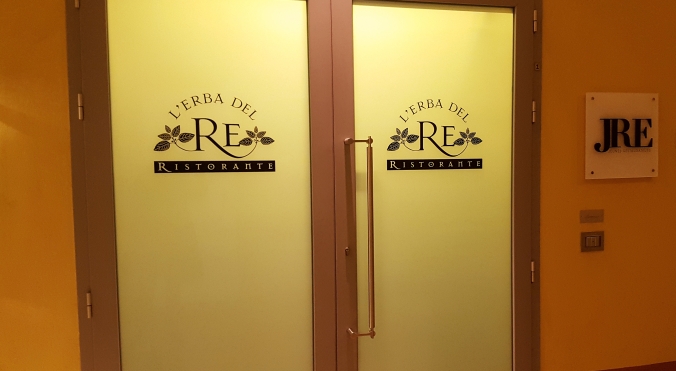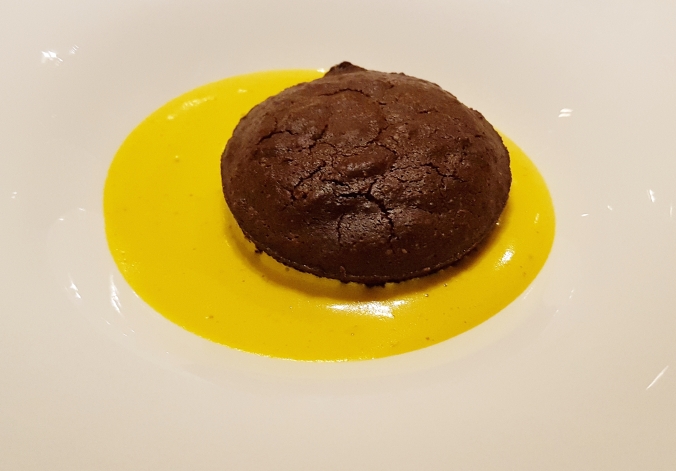
“Passion, sensitivity, humility and seriousness might be considered the winning formula to get good results at least in the kitchen.” – Chef Luca Marchini
L’ Erba del Re is a Michelin starred restaurant located near the Pomposa Square in the middle of old Modena and is owned and operated by Chef Luca Marchini, a former student of Chef Massimo Bottura (of Osteria Francescana).

The sommelier opened a new bottle with each course.
The décor of this exquisite restaurant is refined and elegant – a modern setting with classic touches in many of its details. The chef and the sommelier, as well as the rest of the great staff, delivered a flawless experience with outstanding service. There were three different menus ranging from traditional Modenese food to the ten-course chef’s tasting menu with more contemporary interpretations.
We chose the seven-course traditional menu to taste more of the foods that have made Emilia-Romagna famous for many centuries. Chef Marchini uses traditional local ingredients which are elevated, rather than subdued, by modern techniques. We elected to go with the wine pairings and were treated to some very nice regional wines.

Culatello di Zibello and Prosciutto di Parma
The antipasti was a lovely plate of Culatello di Zibello and Prosciutto di Parma, two of the world’s best hams. Culatello, not well known in the U.S., should be tasted whenever available. The hams are carved from the tenderest parts of haunches from large white Zibello pigs. Culatello is produced in a region south of Parma and near the Po River, with a unique micro-climate that has long, cold, humid winters, ideal for aging the hams. Whole hams on the bone will rot before they can properly cure so the meat is filleted and wrapped in a dry pig’s bladder (tasty, yes?) before being aged. Culatello is cured 16 to 37 months and is characterized by a velvety texture and a unique sweetness and fragrance.
Prosciutto di Parma hams that are imported to the U.S., while quite delicious, are definitely not on the same level as the ones we tasted in Modena. Our plate came with thin ham slices by themselves – the best way to appreciate all of their flavors and aromas. My last bite happily lingered for at least half an hour.

Cod, marinated in herbs and deep fried tempura style, was our next dish. Two small and perfectly cooked pieces of fish were centered in the plate paired with caramelized onions. It was fairly simple, but tasty.
Next came pasta – oh my, yes!
The creation of tortellini is credited to a legend that probably began over a thousand years ago. After one of many battles between Modena and Bologna (rivalry continues to this day between the two cities, at least between their football teams), the gods, Jupiter and Venus, retreated to a tavern to spend the night. The innkeeper was so overtaken with Venus’ beauty that he spied on her through a hole in the door. The only part of Venus’s body that he could see was her navel. He crept back down to his kitchen, obsessed by the shape of her belly button, and voilà, he created tortellini!

Tortellini in Capon Brodo
Our tastes perked up exponentially when we caught the scent of Tortellini in Capon Brodo, coming into the dining room. An essential Modenese dish, the handmade “navel-shaped” egg pasta are small, stuffed with ground and blended pork loin, ham, mortadella, eggs, nutmeg and parmigiana cheese. A capon is boiled in water with celery, onion, and herbs for four to five hours and then strained to make the brodo (broth), similar to the way I make chicken stock. The result is a deep, but clear, golden broth with an extravagantly rich taste. Imagine the best homemade chicken noodle soup that your grandmother ever made and then multiply that by a thousand. It is served very hot with the tortellini cooked just al dente since they continue to cook after the dish is served. The combination of the pasta, the filling, and the brodo, created a mini-universe of flavors in my mouth. It was such a delicious comfort food that it set a new high standard for all of the good things to come. I will never be able to look at canned chicken noodle soup again.
Some say that it is impossible to have a bad plate of pasta in Italy. I haven’t eaten at every Italian osteria or trattoria (a worthy challenge) but judging by the places that I have eaten, I agree. At Hosteria Giusti, we had Tagliatelle al ragù di Vitello battuto al coltello. Here it was Tagliatelle con Ragù di stile di Modena. Discovering differences, if any, of the two dishes, was a hard job but I was up to the task!
Tagliatelle at each restaurant had slight differences. Both were handmade, egg-rich and delicious. What difference there was in the dishes was in the ragù and even that was fairly minor. There are thousands of recipes for ragù so there will be a similar, but different, version five kilometers down the street in any direction. All chefs say that their grandmother made the absolute best but there is no right or wrong recipe. The determinant factor in all cuisine that holds true in ragù as well – the best and freshest ingredients are the most important part.

Tagliatelle con Ragù di stile di Modena
Chef Marchini uses five different types of meat in his ragu: beef, pork loin, pancetta, mortadella, and veal. The meats are cut into fairly large pieces (not ground) and braised, then the beef, pork, and veal are shredded by hand and have a deep, rich flavor and better texture than market ground products. Traditionally salt, pepper, and nutmeg – no garlic – are used to flavor the meat. This version was spot on.
Both ragùs tasted delicious with no clear winner. Chef Marchini’s interpretation had a slight edge just because the combination of meats gave a more complex taste. Another person may reverse them and that is how it should be. In any event, we loved them both.
Our next course, risotto, has been one of my all-time favorite dishes since I discovered the recipe in the October 1990, issue of Food and Wine and yes, I still have that magazine in my kitchen bookcase. After tasting and cooking many versions, I have decided that Arborio rice, cooked in heated broth and flavored with butter, saffron, and lots of Parmigiano Reggiano cheese is the best way to go. OK, sometimes I throw in some porcini mushrooms.

Risotto al Parmigiano Reggiano e Aceto Balsamico alla Modena
Here we had Risotto al Parmigiano Reggiano e Aceto Balsamico alla Modena. Aceto balsamico, or balsamic vinegar, is a rich, dark, syrupy brew that is aged for a minimum of twelve years or up to twenty-five years (occasionally up to fifty years albeit with a commensurate price). The elixir comes from pressed Trebbiano and Lambrusco grapes that have been aged and reduced in a battery of six barrels of descending size and of different woods, chosen for specific flavors. It can only be produced in Modena and Reggio Emilia as it has been since 1046 AD. Fred Plotkin, author of Italy for the Gourmet Traveler, wrote that to describe Aceto Balsamico as vinegar is like describing Pavarotti as a street singer. I have drizzled it over everything from Parmigiano Reggiano, risotto, cured meats, fresh and grilled stone fruit and even ice cream.
In this dish, a drizzle of Aceto Balsamico gives a flavor punch to creamy white risotto (no saffron) and complements the cheese in a very sophisticated style. The taste was truly exquisite and was a welcome light interlude after the heavier pasta dishes.

Cotoletta alla Bolognese
The classic Cotoletta alla Bolognese was our final savory course. A thick slice of milk-fed veal is dredged in Parmigiano Reggiano, dipped in beaten farm eggs, and coated with breadcrumbs. It is fried until crisp, covered with Prosciutto di Parma and Fontina cheese and simmered in a reduction of cream, butter and broth until the cheese was melted. Diced roasted potatoes helped soak up every last bit of sauce. A delicious Bolognese dish.

Torta Barozzi
Torta Barozzi, or Barozzi Cake, originated in a pasticceria in Vignola (just outside Modena) and was dedicated to native son Jacopo Barozzi (1507-1573), a famous Renaissance architect credited with designing the spiral staircase. The cake was created in 1907 (or 1897 depending on the source) by Eugenio Gollini, great grandfather of the current pasticceria owners who have sworn to never reveal or change their well-kept secret recipe. I do know that it was a dense, flourless chocolate cake flavored with rum, coffee, and almonds. Chef Marchini’s interpretation has a moist, fudgy texture, punctuated with crunchy ground almonds. Just in case the dark-as-midnight low-rise cake is not evil enough on its own, it is plated floating in Zabaglione, flavored with the traditional Marsala wine. Our Torta Barozzi delivered a plethora of sinfully delicious taste sensations. I ate every morsel and would worry about the calorie count on another day.
Ciao!
Another great post!
Never banal and so “elegant”.
Thank a lot for loving so much my country.
Alberto
LikeLiked by 1 person
Thanks so much, Alberto. I am so happy that you are enjoying my posts.
I love Italy. Every place in your wonderful country has been a delight.
LikeLike
Bro, Mouth a’watering from this one! Italiano Amore! Jim
Sent from my iPhone
>
LikeLike
This was a GREAT meal! Walter, you described it perfectly!
LikeLiked by 1 person
Pingback: La Grassa | UPROOTED